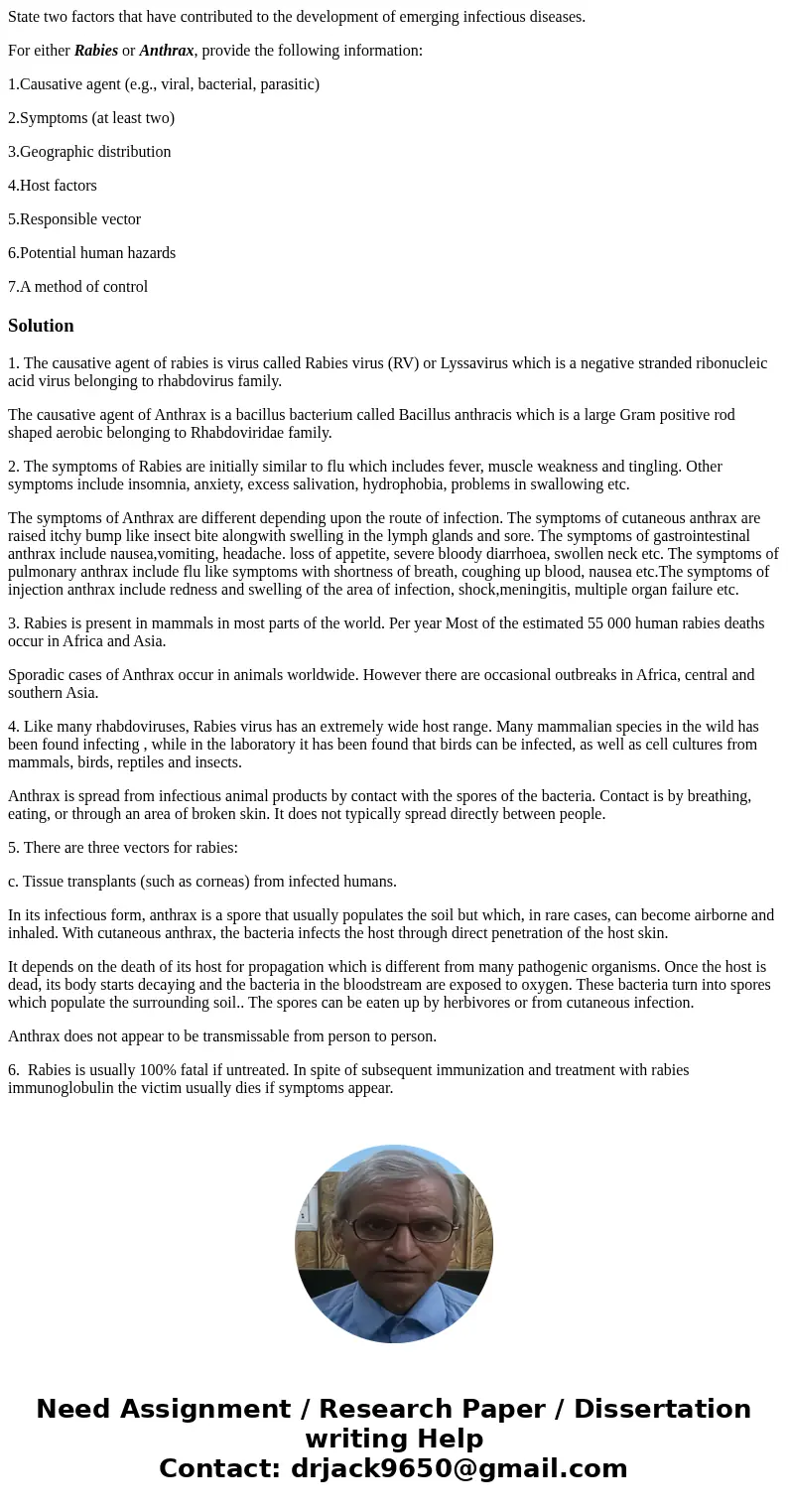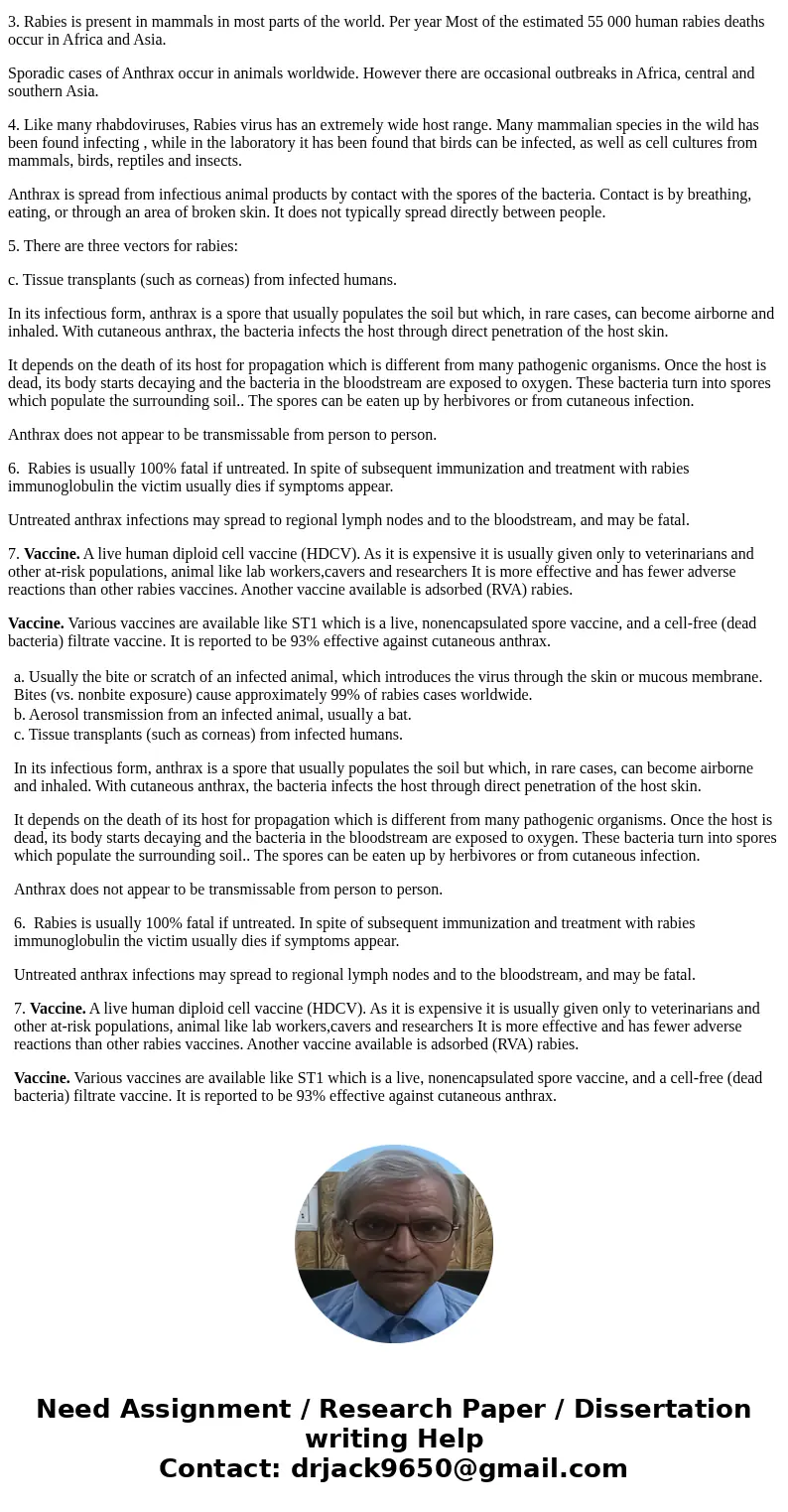State two factors that have contributed to the development o
State two factors that have contributed to the development of emerging infectious diseases.
For either Rabies or Anthrax, provide the following information:
1.Causative agent (e.g., viral, bacterial, parasitic)
2.Symptoms (at least two)
3.Geographic distribution
4.Host factors
5.Responsible vector
6.Potential human hazards
7.A method of control
Solution
1. The causative agent of rabies is virus called Rabies virus (RV) or Lyssavirus which is a negative stranded ribonucleic acid virus belonging to rhabdovirus family.
The causative agent of Anthrax is a bacillus bacterium called Bacillus anthracis which is a large Gram positive rod shaped aerobic belonging to Rhabdoviridae family.
2. The symptoms of Rabies are initially similar to flu which includes fever, muscle weakness and tingling. Other symptoms include insomnia, anxiety, excess salivation, hydrophobia, problems in swallowing etc.
The symptoms of Anthrax are different depending upon the route of infection. The symptoms of cutaneous anthrax are raised itchy bump like insect bite alongwith swelling in the lymph glands and sore. The symptoms of gastrointestinal anthrax include nausea,vomiting, headache. loss of appetite, severe bloody diarrhoea, swollen neck etc. The symptoms of pulmonary anthrax include flu like symptoms with shortness of breath, coughing up blood, nausea etc.The symptoms of injection anthrax include redness and swelling of the area of infection, shock,meningitis, multiple organ failure etc.
3. Rabies is present in mammals in most parts of the world. Per year Most of the estimated 55 000 human rabies deaths occur in Africa and Asia.
Sporadic cases of Anthrax occur in animals worldwide. However there are occasional outbreaks in Africa, central and southern Asia.
4. Like many rhabdoviruses, Rabies virus has an extremely wide host range. Many mammalian species in the wild has been found infecting , while in the laboratory it has been found that birds can be infected, as well as cell cultures from mammals, birds, reptiles and insects.
Anthrax is spread from infectious animal products by contact with the spores of the bacteria. Contact is by breathing, eating, or through an area of broken skin. It does not typically spread directly between people.
5. There are three vectors for rabies:
c. Tissue transplants (such as corneas) from infected humans.
In its infectious form, anthrax is a spore that usually populates the soil but which, in rare cases, can become airborne and inhaled. With cutaneous anthrax, the bacteria infects the host through direct penetration of the host skin.
It depends on the death of its host for propagation which is different from many pathogenic organisms. Once the host is dead, its body starts decaying and the bacteria in the bloodstream are exposed to oxygen. These bacteria turn into spores which populate the surrounding soil.. The spores can be eaten up by herbivores or from cutaneous infection.
Anthrax does not appear to be transmissable from person to person.
6. Rabies is usually 100% fatal if untreated. In spite of subsequent immunization and treatment with rabies immunoglobulin the victim usually dies if symptoms appear.
Untreated anthrax infections may spread to regional lymph nodes and to the bloodstream, and may be fatal.
7. Vaccine. A live human diploid cell vaccine (HDCV). As it is expensive it is usually given only to veterinarians and other at-risk populations, animal like lab workers,cavers and researchers It is more effective and has fewer adverse reactions than other rabies vaccines. Another vaccine available is adsorbed (RVA) rabies.
Vaccine. Various vaccines are available like ST1 which is a live, nonencapsulated spore vaccine, and a cell-free (dead bacteria) filtrate vaccine. It is reported to be 93% effective against cutaneous anthrax.
| a. Usually the bite or scratch of an infected animal, which introduces the virus through the skin or mucous membrane. Bites (vs. nonbite exposure) cause approximately 99% of rabies cases worldwide. | ||
| b. Aerosol transmission from an infected animal, usually a bat. | ||
| c. Tissue transplants (such as corneas) from infected humans. In its infectious form, anthrax is a spore that usually populates the soil but which, in rare cases, can become airborne and inhaled. With cutaneous anthrax, the bacteria infects the host through direct penetration of the host skin. It depends on the death of its host for propagation which is different from many pathogenic organisms. Once the host is dead, its body starts decaying and the bacteria in the bloodstream are exposed to oxygen. These bacteria turn into spores which populate the surrounding soil.. The spores can be eaten up by herbivores or from cutaneous infection. Anthrax does not appear to be transmissable from person to person. 6. Rabies is usually 100% fatal if untreated. In spite of subsequent immunization and treatment with rabies immunoglobulin the victim usually dies if symptoms appear. Untreated anthrax infections may spread to regional lymph nodes and to the bloodstream, and may be fatal. 7. Vaccine. A live human diploid cell vaccine (HDCV). As it is expensive it is usually given only to veterinarians and other at-risk populations, animal like lab workers,cavers and researchers It is more effective and has fewer adverse reactions than other rabies vaccines. Another vaccine available is adsorbed (RVA) rabies. Vaccine. Various vaccines are available like ST1 which is a live, nonencapsulated spore vaccine, and a cell-free (dead bacteria) filtrate vaccine. It is reported to be 93% effective against cutaneous anthrax. |


 Homework Sourse
Homework Sourse